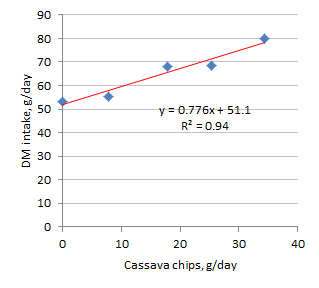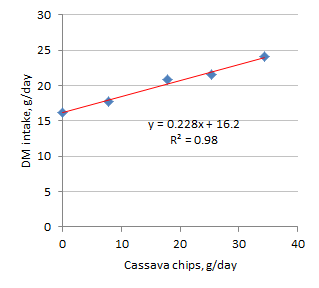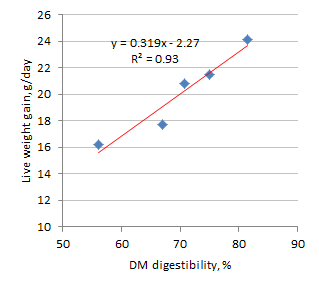 |
 |
| Figure 1. Relationship between daily intake of cassava chips and total DM intake | Figure 2. Relationship between daily intake of cassava chips and growth rate |
|
Live stock production, climate change and resource depletion |
In a feeding trial, 60 crossbred rabbits with average initial live weight of 735±4.64g and 8 weeks of age were fed 5 levels of dried cassava chips (0, 10, 20, 30 and 40 g/rabbit/day) as a supplement to Para grass fed ad libitum. In experiment 2, 30 crossbred rabbits at 12 weeks of age with average live weight of 1213±147g were used to measure digestibility and N balance.
Increasing the offer level of dried cassava chips in a basal diet of Para grass fed to growing rabbits led to linear increases in total DM intake, live weight gain, coefficients of apparent digestibility and N retention. There were positive linear relationships between coefficients of apparent DM digestibility and live weight gain and N retention. It was proposed that the determinant of rabbit growth rate in forage-based diets is the overall apparent digestibility of the diet rather than the composition of the diet in terms of the relative proportions of soluble and structural carbohydrates.
Rabbits are raised in almost all developing countries, including Vietnam, and contribute to improving the nutrition and economy of famer smallholders, both as a source of animal protein as well as a source of extra income. Rabbit meat has been also considered as good meat for it's high content of protein , low fat and low cholesterol levels (Owen 1992).
In the Mekong delta of Vietnam feeding of rabbits is mainly based on natural grasses and agro-industrial by products (Nguyen Thi Kim Dong and Nguyen Van Thu 2009) so the cost for rabbit production is lower than for the other animal species ones. This study aimed to evaluate the potential benefits from supplementing Para grass with dried cassava chips in diets of growing rabbits.
Two experiments were carried out at the Experimental farm in Cantho City. For the feeding trial, sixty crossbred rabbits (local x improved breeds) at 8 weeks of age with average initial weight around 735g, were arranged in a completely randomized design with 5 treatments and 3 replications. Four rabbits balanced for sex were the experimental unit. The treatments were dried cassava chips (DC) supplemented to the Para grass (PG) basal diet at levels of 0 (DC0), 10 (DC10), 20 (DC20), 30 (DC30) and 40g (DC40) / day/ animal. Soybean waste was offered at 150g/day/animal and extracted soybean meal was fed at 7-11g/day/animal for adjustment of the same protein level of 11.5g/day/rabbit. The experimental period lasted 9 weeks.
In the digestibility trial, the experimental design was similar to that of the feeding trial; 30 rabbits at 12 weeks-old with live weight around 1200g were used. The animals had two week for adaptation and another week for feces and urine collection. Feeds offered and refusals were measured daily. Urine was collected for nitrogen analysis to calculate the nitrogen retention. DM, CP, EE, and NDF apparent digestibility coefficients were calculated according to McDonald et al (2002).
Para grass was collected daily in the areas surrounding the farm. Soybean waste was bought daily from the soybean milk factory in the city; cassava chips and extracted soybean meal were bought on one occasion from an animal feed shop for using throughout the trials. The animals were fed three times a day at 7:30h, 14:00h and 18:00h. Fresh water was always available. The animals were vaccinated against rabbit hemorrhagic and parasite diseases.
The measurements taken were intakes of dry matter (DM), organic matter (OM), ash, neutral detergent fiber (NDF), daily weight gain, feed conversion ratio, economic returns, nutrient digestibility and nitrogen retention. Chemical analyses of DM, OM, CP, EE, CF, NDF and Ash followed the procedure of AOAC (1990) and Van Soest et al (1991).
The data were analyzed using the General Linear Model (GLM) option in the ANOVA program of the Minitab software (Minitab 2000). The comparison of differences between two treatments was done by the Tukey option of Minitab (2000).
The values for ingredient composition (Table 1) are in agreement with those compiled by Gőhl (1971).
|
Table 1: Chemical composition of feeds (% in DM except for DM which is on fresh basis, and ME ) in the feeding trial |
||||||||
|
|
DM |
OM |
CP |
EE |
CF |
NDF |
Ash |
ME MJ/kg |
|
Para grass |
17.4 |
89.6 |
12.3 |
5.09 |
28.9 |
67.1 |
11.2 |
8.72 |
|
Dried cassava chips |
94.3 |
97.1 |
2.70 |
1.59 |
3.39 |
15.6 |
3.09 |
13.4 |
|
Soya waste |
12.0 |
95.3 |
21.3 |
15.4 |
3.50 |
35.0 |
4.96 |
13.1 |
|
Extracted soybean |
87.9 |
90.1 |
42.8 |
3.22 |
3.70 |
27.4 |
11.3 |
12.4 |
|
DM: dry
matter, OM: organic matter, CP: crude protein, NDF: neutral
detergent fiber. |
||||||||
Feed intake and growth performance
Intake of Para grass declined as the offer level of cassava chips was increased (Table 2). Actual intake of cassava chips was slightly less than the offer level, but was strongly and positively related to total DM intake and growth rate (Table 3; Figures 1 and 2). Strangely, there was no relationship between cassava chip intake and feed conversion. Under the conditions in Vietnam, economic benefits were increased by almost 70% by supplementing Para grass with cassava chips (Table 3). The results are in marked contrast with those reported by Hongthong Phimmmasan et al (2004), where there was no improvement in growth rate of rabbits when a water spinach basal diet was supplemented with broken rice, a carbohydrate source of similar composition to cassava chips. The reason may be that the response to supplementation with a starch-rich carbohydrate is more a function of the effect on the digestibility of the diet, than of the nature of the carbohydrate. In this respect, the digestibility of Para grass is considerably inferior to that of water spinach (Nguyen Thi Kim Dong et al 2006). Supporting evidence for this hypothesis is presented in the results from Experiment 2.
|
Table 2: Daily intakes of feeds (g DM/animal) and fed components (g/animal) of rabbits in the feeding trial |
||||||
|
Item |
Treatment |
SEM/P |
||||
|
DC0 |
DC10 |
DC20 |
DC30 |
DC40 |
||
|
Cassava chips |
- |
7.80a |
17.8b |
25.4c |
34.3d |
1.03/0.001 |
|
Para grass |
31.7a |
25.3b |
25.7b |
20.0c |
22.3bc |
2.00/0.001 |
|
DM |
53.4a |
55.2a |
68.2b |
68.5b |
79.9c |
1.43/0.001 |
|
OM |
48.7a |
51.0a |
63.4b |
64.3b |
75.3c |
1.33/0.001 |
|
CP |
11.0 |
10.4 |
11.2 |
10.3 |
10.6 |
0.26/0.140 |
|
EE |
4.02ab |
3.92a |
4.47bc |
4.18abc |
4.55c |
0.11/0.008 |
|
NDF |
28.0a |
25.1ab |
27.8ab |
24.7b |
27.7ab |
0.69/0.012 |
|
ME, MJ/animal |
0.56a |
0.62a |
0.79b |
0.82b |
0.96c |
0.16/0.001 |
|
DC0: basal diet, DC10, DC20,DC30 and
DC40: DC supplementation at levels of 10, 20, 30, and 40g,
respectively. |
||||||
|
Table 3: Mean values for changes in live weight, feed conversion and economic return |
||||||
|
Item |
Treatment |
SEM/P |
||||
|
DC0 |
DC10 |
DC20 |
DC30 |
DC40 |
||
|
Initial weight, g |
737 |
735 |
738 |
727 |
738 |
5.53/0.567 |
|
Final weight, g |
1755a |
1848ab |
2047abc |
2083bc |
2255c |
67.5/0.003 |
|
Daily gain, g |
16.2a |
17.7ab |
20.8abc |
21.5bc |
24.1c |
1.09/0.002 |
|
FCR |
3.33 |
3.13 |
3.28 |
3.18 |
3.35 |
0.14/0.761 |
|
Total cost, VND |
61,268 |
63,194 |
67,534 |
69,393 |
72,709 |
|
|
Total income, VND |
78,975 |
83,175 |
92,100 |
93,750 |
101,475 |
|
|
Net income, VND |
17,707 |
19,981 |
24,566 |
24,357 |
28,766 |
|
|
Means with different letters within the same row are different at P<0.05 |
||||||
 |
 |
| Figure 1. Relationship between daily intake of cassava chips and total DM intake | Figure 2. Relationship between daily intake of cassava chips and growth rate |
Cassava chip supplementation had no effect on the proportions of total lean meat and thigh lean meat in the carcass but increased the meat: bone ratio (Table 4). When corrected for final live weight, the weight and length of the caecum was decreased by cassava chip supplementation, presumably reflecting the reduction in dietary fiber as cassava chips replaced Para grass.
|
Table 4: Mean values of slaughter weights, carcass traits and internal organs of growing rabbits |
||||||
|
Item |
Treatment |
SEM/P |
||||
|
DC0 |
DC10 |
DC20 |
DC30 |
DC40 |
||
|
Live weight, g |
1785a |
1887 a |
2068 ab |
2081ab |
2291b |
73.0/0.005 |
|
Carcass weight, g |
852a |
904a |
955a |
1019ab bc |
1143b |
51.0/0.019 |
|
% Carcass |
47.7 |
47.9 |
46.1 |
49.0 |
49.8 |
1.19/0.32 |
|
% Lean meat |
73.9 |
75.3 |
72.4 |
68.8 |
77.3 |
1.89/0.08 |
|
% Thigh |
28.5 |
26.8 |
25.6 |
28.6 |
28.5 |
1.59/0.61 |
|
Lean meat/bone |
3.11 |
3.08 |
3.18 |
3.49 |
3.89 |
0.44/0.34 |
|
Caecum length, cm/kg LW |
28.2 |
28.5 |
23.4 |
26.6 |
26.0 |
|
|
Caecum weight, g/kg LW |
8.18 |
7.37 |
7.06 |
7.16 |
6.42 |
|
|
Means with different letters within the same rows are different at P<0.05 |
||||||
The ingredients used in this experiment were similar in composition (Table 5) to those used in the feeding trial.
Table 5: Chemical composition of feed ingredients (% in DM, except for DM which is on fresh basis) in the digestibility trial |
||||||||
|
Feed |
DM |
OM |
CP |
EE |
CF |
NDF |
Ash |
ME# |
|
Para grass |
21.4 |
87.7 |
10.9 |
4.97 |
28.9 |
67.4 |
12.8 |
8.41 |
|
Dried cassava chips |
93.8 |
97.5 |
2.58 |
1.60 |
3.39 |
16.4 |
2.67 |
13.4 |
|
Soya waste |
12.7 |
95.2 |
21.6 |
15.6 |
3.50 |
33.5 |
5.3 |
13.1 |
|
Extracted soybean |
87.9 |
90.1 |
42.8 |
3.22 |
3.70 |
26.3 |
11.3 |
12.4 |
|
# Calculated as MJ/kg DM ( Marteans et al 2002) |
||||||||
The trends in intake of Para grass and total DM were similar to those in Experiment 1 (Table 6). Coefficients of apparent digestibility of all dietary components increased linearly as the offer level of cassava chips was increased. N retention expressed as a function of metabolic live weight showed the same trend.
Table 6 . Apparent nutrient digestibility (%) and nitrogen retention (g/kg W0.75) of rabbits |
||||||
|
Treatment |
SEM/P |
|||||
|
DC0 |
DC10 |
DC20 |
DC30 |
DC40 |
||
|
DM intake, g/day |
||||||
|
Cassava chips |
0 |
7.80 |
17.5 |
24.9 |
36.6 |
|
|
Para grass |
40.3 |
35.8 |
36.0 |
34.1 |
34.0 |
2.05/0.259 |
|
Total |
63.6a |
67.1a |
78.4ab |
82.9b |
92.9b |
3.77/0.002 |
|
Apparent digestibility, % |
|
|
|
|||
|
DM |
56.0a |
66.9b |
70.8bc |
75.0cd |
81.4d |
1.71/0.001 |
|
OM |
56.5a |
70.0b |
71.9bc |
76.4cd |
82.6d |
1.60/0.001 |
|
CP |
78.7 |
79.3 |
80.5 |
80.7 |
81.9 |
1.82/0.742 |
|
EE |
72.6a |
74.9ab |
78.0ab |
82.3bc |
86.9c |
1.70/0.001 |
|
NDF |
46.9a |
55.9ab |
58.9b |
62.6bc |
70.9c |
2.01/0.001 |
|
Nitrogen balance (g//kgW0.75) |
||||||
|
Nitrogen intake |
0.97 |
0.93 |
0.90 |
0.98 |
0.88 |
0.07/0.796 |
|
Nitrogen retention |
0.48 |
0.48 |
0.53 |
0.58 |
0.64 |
0.05/0.208 |
|
Means with different letters within the same rows are different at P<0.05 |
||||||
In the discussion of experiment 1, it was hypothesized that the positive effect of supplementation with starch-rich carbohydrate was probably the result of increasing diet digestibility as Para grass was replaced by cassava root chips. The results from experiment 2 appear to confirm this hypothesis, as observed in the positive linear relationships between percentage apparent DM digestibility (experiment 2) and live weight gain in experiment 1 (Figure 3) and with N retention in experiment 2 (Figure 4). In trials with water spinach replacing Para grass, similar positive relationships were observed between apparent DM digestibility and live weight gain (Nguyen Thi Kim Dong et al 2006). Replacing 75% of the Para grass in he diet with water spinach increased apparent DM digestibility from 63 to 73% and growth rate from 13 to 19 g/day.
 |
 |
| Figure 3. Relationship between DM apparent digestibility (from experiment 2) and live weight gain (from Experiment 1) | Figure 4. Relationship between DM apparent digestibility ( and N retention (from Experiment 2) |
The authors acknowledge the support for this research received from the MEKARN program, financed by Sida.
References
AOAC 1990: Official methods of analysis (15th edition), Washington, DC, Volume 1: 69-90.
Hongthong Phimmmasan, Siton Kongvongxay, Chhay Ty and Preston T R 2004: Water spinach (Ipomoea aquatica) and Stylo 184 (Stylosanthes guianensis CIAT 184) as basal diets for growing rabbits. Livestock Research for Rural Development. Vol. 16, Art. #34. Retrieved December 15, 111, from http://www.cipav.org.co/lrrd/lrrd16/5/hong16034.htm
Maertens L, Peter J M, Villamide M, Cervera C, Gidenne T and Xiccato G 2002: Nutritive value of raw materials for rabbit. World Rabbit Science 10 (4), pp. 157-166.
McDonald P, R A Edwards, J F D Greehalgh and C A Morgan 2002: Animal Nutrition 6th Edition, Longman Scientific and Technical, New York, pp: 245-255.
Minitab 2000: Minitab reference manual release 13.20. Minitab Inc.
Nguyen Thi Kim Dong, Nguyen Van Thu, Ogle R B and Preston T R 2006: Effect of supplementation level of water spinach (Ipomoea aquatica) leaves in diets based on para grass (Brachiaria mutica) on intake, nutrient utilization, growth rate and economic returns of crossbred rabbits in the Mekong Delta of Vietnam. Workshop-seminar "Forages for Pigs and Rabbits" MEKARN-CelAgrid, Phnom Penh, Cambodia, 22-24 August, 2006. Article # 20. RetrievedDecember 15, 111, from http://www.mekarn.org/proprf/kimd2.htm
Nguyen Thi Kim Dong and Nguyen Van Thu 2009: The use of agro-industrial by productsfor raising crossbred rabbits in the Mekong delta of Vietnam. Conference on Asian Rabbit Production Development. Sep 10-11 2009. Changchun, China.pp: 156.
Owen J B 1992: Genetic aspects of appetite and food choice by animals. Journal of Agricultural Science 119: 151-155.
Van Soest P J, J B Robertson and B A Lewis 1991: Symposium: Carbohydrate methodology, metabolism and nutritional implications in dairy cattle: methods for dietary fiber, and nonstarch polysaccharides in relation to animal nutrition. Journal Dairy Sci.ence 74: 3585-3597.